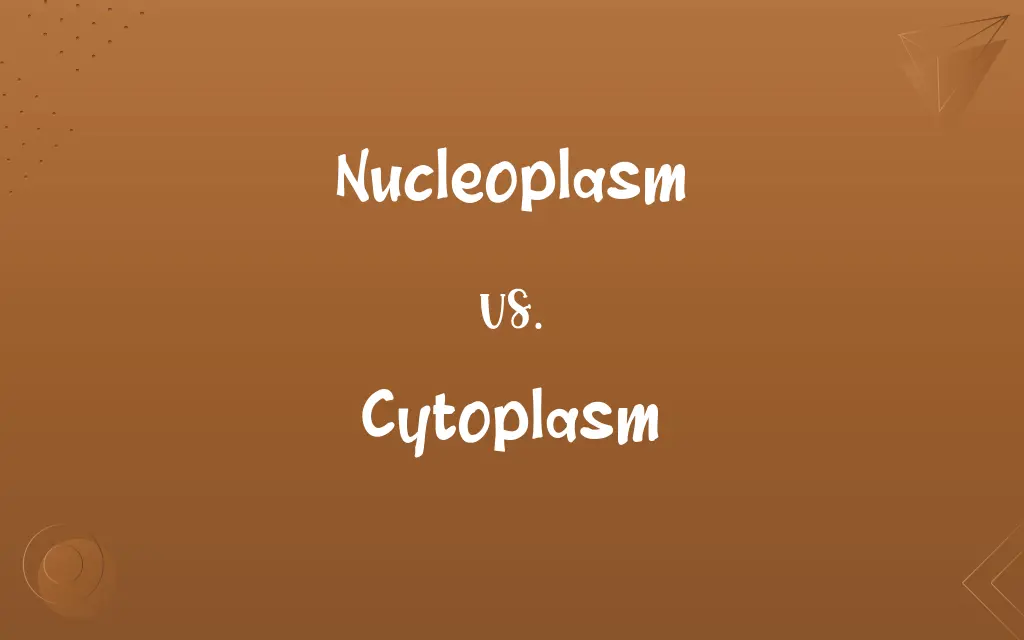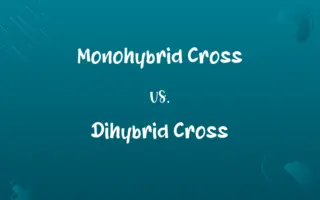Nucleoplasm vs. Cytoplasm: Know the Difference

By Shumaila Saeed || Published on February 19, 2024
Nucleoplasm is the gel-like substance within the nucleus, housing DNA and nucleolus, whereas cytoplasm is the cell's fluid, surrounding all cellular components except the nucleus.

Key Differences
Nucleoplasm, found inside the cell nucleus, is a viscous fluid that contains the chromatin and nucleolus, vital for DNA replication and RNA transcription. Cytoplasm, in contrast, is the jelly-like fluid that occupies the cell space outside the nucleus, encompassing various organelles and playing a key role in cellular metabolism and transport.
Shumaila Saeed
Feb 19, 2024
The nucleoplasm serves as a matrix for the components of the nucleus, supporting and protecting genetic material and associated processes. Cytoplasm, on the other hand, acts as a site for most cellular activities, including glycolysis, protein synthesis, and cellular division, being the venue for the majority of the cell's biochemical reactions.
Shumaila Saeed
Feb 19, 2024
In terms of composition, nucleoplasm is rich in nucleic acids, enzymes, and nucleotide pools, essential for genetic functions. Conversely, the cytoplasm contains cytosol, organelles like mitochondria and ribosomes, and various enzymes, facilitating diverse cellular functions from energy production to waste removal.
Shumaila Saeed
Feb 19, 2024
Nucleoplasm plays a critical role in gene expression regulation and the maintenance of nuclear structure. The cytoplasm, however, is pivotal in maintaining cell structure, providing a medium for molecular movement, and aiding in intracellular transport and communication.
Shumaila Saeed
Feb 19, 2024
Both nucleoplasm and cytoplasm are crucial for the survival and functioning of the cell, with nucleoplasm focusing on genetic and nuclear activities, while cytoplasm encompasses broader cellular processes, including metabolism and structural integrity.
Shumaila Saeed
Feb 19, 2024
ADVERTISEMENT
Comparison Chart
Main Components
Chromatin, nucleolus, nucleic acids, enzymes
Cytosol, organelles, enzymes
Shumaila Saeed
Feb 19, 2024
Primary Functions
DNA replication, RNA transcription, gene regulation
Metabolism, protein synthesis, cellular processes
Shumaila Saeed
Feb 19, 2024
Role in Cell
Genetic control and nuclear structure maintenance
Cellular metabolism, structure, and transport
Shumaila Saeed
Feb 19, 2024
Relation to Cellular Organelles
Exclusive to the nucleus
Encompasses all organelles except the nucleus
Shumaila Saeed
Feb 19, 2024
ADVERTISEMENT
Nucleoplasm and Cytoplasm Definitions
Nucleoplasm
Nucleoplasm is the semi-fluid substance inside the nucleus of a cell.
The nucleoplasm contains the genetic material that dictates the cell's functions.
Shumaila Saeed
Jan 18, 2024
Cytoplasm
Cytoplasm is the jelly-like fluid that fills a cell outside the nucleus.
The cytoplasm is the site where most cellular metabolic reactions occur.
Shumaila Saeed
Jan 18, 2024
Nucleoplasm
Nucleoplasm is involved in the storage and processing of genetic information.
The nucleoplasm ensures the proper functioning of the cell's genetic machinery.
Shumaila Saeed
Jan 18, 2024
Cytoplasm
Cytoplasm plays a crucial role in maintaining cell structure and shape.
The cytoskeleton within the cytoplasm provides structural support to the cell.
Shumaila Saeed
Jan 18, 2024
Nucleoplasm
Nucleoplasm provides a medium for nuclear processes like DNA and RNA synthesis.
Enzymes within the nucleoplasm facilitate the transcription of DNA.
Shumaila Saeed
Jan 18, 2024
ADVERTISEMENT
Cytoplasm
Cytoplasm contains all organelles and cellular components, excluding the nucleus.
Mitochondria and ribosomes function within the cytoplasm.
Shumaila Saeed
Jan 18, 2024
Nucleoplasm
Nucleoplasm contains the nucleolus and chromatin material.
The nucleoplasm's composition is vital for the formation of ribosomes.
Shumaila Saeed
Jan 18, 2024
Cytoplasm
Cytoplasm aids in intracellular transport and molecular movement.
Nutrients and organelles move through the cytoplasm to reach different parts of the cell.
Shumaila Saeed
Jan 18, 2024
Nucleoplasm
Nucleoplasm plays a role in the regulation of gene expression and nuclear integrity.
Alterations in the nucleoplasm can affect gene expression patterns.
Shumaila Saeed
Jan 18, 2024
Cytoplasm
Cytoplasm is involved in various biochemical processes like glycolysis.
Enzymatic reactions of glycolysis occur in the cytoplasm of the cell.
Shumaila Saeed
Jan 18, 2024
Cytoplasm
The protoplasm enclosed by the plasma membrane of cell, excluding the nucleus in eukaryotic cells and cellular DNA in prokaryotic cells.
Shumaila Saeed
Jan 18, 2024
Cytoplasm
(cytology) The contents of a cell except for the nucleus. It includes cytosol, organelles, vesicles, and the cytoskeleton.
Shumaila Saeed
Jan 18, 2024
Nucleoplasm
The matter composing the nucleus of a cell; the protoplasm of the nucleus; karyoplasma.
Shumaila Saeed
Jan 18, 2024
Cytoplasm
The substance of the body of a cell, as distinguished from the karyoplasma, or substance of the nucleus.
Shumaila Saeed
Jan 18, 2024
Repeatedly Asked Queries
What is nucleoplasm?
Nucleoplasm is the gel-like substance within the cell nucleus.
Shumaila Saeed
Feb 19, 2024
What is cytoplasm?
Cytoplasm is the jelly-like fluid occupying the cell space outside the nucleus.
Shumaila Saeed
Feb 19, 2024
What is the role of nucleoplasm in the cell?
Nucleoplasm supports genetic processes like DNA replication and RNA transcription.
Shumaila Saeed
Feb 19, 2024
What are the main components of cytoplasm?
Cytoplasm contains cytosol, organelles like mitochondria and ribosomes, and enzymes.
Shumaila Saeed
Feb 19, 2024
What does nucleoplasm contain?
Nucleoplasm contains chromatin, the nucleolus, and various enzymes and nucleic acids.
Shumaila Saeed
Feb 19, 2024
How does nucleoplasm differ from cytoplasm?
Nucleoplasm is confined to the nucleus, while cytoplasm encompasses the rest of the cell.
Shumaila Saeed
Feb 19, 2024
Can nucleoplasm be seen under a microscope?
Yes, nucleoplasm can be observed under a microscope within the nucleus.
Shumaila Saeed
Feb 19, 2024
Is nucleoplasm involved in gene regulation?
Yes, nucleoplasm plays a significant role in regulating gene expression.
Shumaila Saeed
Feb 19, 2024
How does cytoplasm contribute to cellular function?
Cytoplasm is vital for metabolism, protein synthesis, and intracellular transport.
Shumaila Saeed
Feb 19, 2024
Is the nucleoplasm composition constant?
No, nucleoplasm composition can change based on the cell cycle and cellular activity.
Shumaila Saeed
Feb 19, 2024
What role does cytoplasm play in protein synthesis?
Cytoplasm contains ribosomes where protein synthesis occurs.
Shumaila Saeed
Feb 19, 2024
How does cytoplasm interact with cellular organelles?
Cytoplasm provides a medium for organelles to function and interact.
Shumaila Saeed
Feb 19, 2024
Can changes in cytoplasm affect cellular health?
Yes, alterations in cytoplasm can impact cellular metabolism and overall function.
Shumaila Saeed
Feb 19, 2024
How does the nucleoplasm support the nucleolus?
The nucleoplasm provides a medium for the nucleolus to synthesize ribosomal RNA.
Shumaila Saeed
Feb 19, 2024
How does cytoplasm aid in nutrient transport?
Cytoplasm facilitates the movement of nutrients and organelles within the cell.
Shumaila Saeed
Feb 19, 2024
What is the significance of cytoplasmic streaming?
Cytoplasmic streaming helps distribute materials and facilitates cellular communication.
Shumaila Saeed
Feb 19, 2024
Can the state of nucleoplasm affect cell division?
Yes, the state of nucleoplasm can influence the process of cell division.
Shumaila Saeed
Feb 19, 2024
Are there enzymes in nucleoplasm?
Yes, nucleoplasm contains enzymes essential for nuclear processes.
Shumaila Saeed
Feb 19, 2024
What happens in the cytoplasm during cell division?
During cell division, the cytoplasm divides to form two daughter cells.
Shumaila Saeed
Feb 19, 2024
Does nucleoplasm contain DNA?
Yes, nucleoplasm contains DNA as part of the chromatin.
Shumaila Saeed
Feb 19, 2024
Share this page
Link for your blog / website
HTML
Link to share via messenger
About Author
Written by
Shumaila SaeedShumaila Saeed, an expert content creator with 6 years of experience, specializes in distilling complex topics into easily digestible comparisons, shining a light on the nuances that both inform and educate readers with clarity and accuracy.








































































